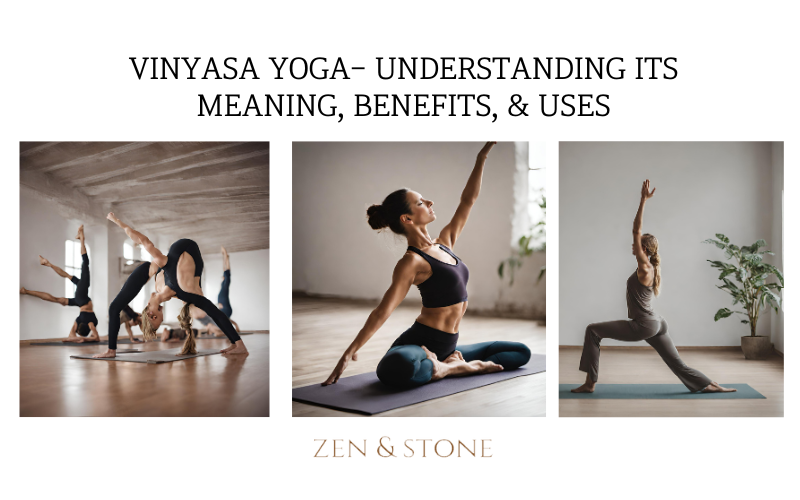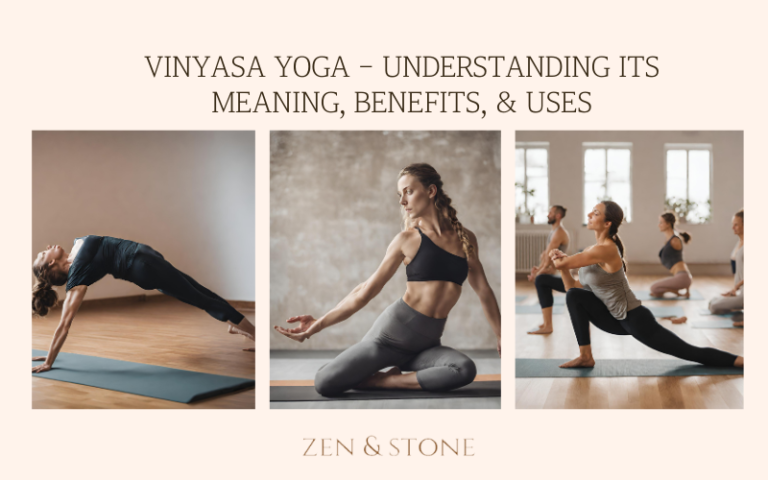
15 Oct Vinyasa Yoga – Understanding its Meaning, Benefits, & Uses
Vinyasa yoga is a popular form of yoga that involves moving through a series of poses in a continuous flow, synchronized with the breath. It is a dynamic and physically challenging practice that can help improve strength, flexibility, and cardiovascular health. Vinyasa yoga is also known for its mental benefits, such as reducing stress and promoting mindfulness.
Key Takeaways
- Vinyasa yoga is a popular form of yoga that involves moving through a series of poses in a continuous flow, synchronized with the breath.
- Vinyasa yoga has a rich history that can be traced back to the ancient practice of Ashtanga yoga, and has evolved into a more accessible and adaptable form of yoga.
- Vinyasa yoga offers a wide range of benefits for physical, mental, and spiritual health, and can be adapted to suit a variety of needs and goals.
What is Vinyasa Yoga
Vinyasa Yoga is a popular style of yoga that emphasizes the synchronization of breath and movement. It is characterized by a continuous flow of yoga poses that are linked together by the breath. The word “vinyasa” comes from the Sanskrit word “nyasa,” which means “to place,” and “vi,” which means “in a special way.” In Vinyasa Yoga, poses are placed in a special way to create a flowing sequence that is both dynamic and meditative.
Vinyasa Yoga is also known as “flow yoga” because of the smooth way the poses run together. It is one of the most popular contemporary styles of yoga, and it is often practiced in the West. Vinyasa Yoga is a great way to get your heart rate up and work up a sweat, as the continuous flow of movement helps to build strength, flexibility, and endurance.
In Vinyasa Yoga, the breath is used as a tool to help practitioners move through the poses with ease and grace. Each movement is synchronized with an inhale or an exhale, and the breath is used to create a sense of rhythm and flow. This helps to quiet the mind and bring a sense of focus and awareness to the practice.
Vinyasa Yoga is suitable for all levels of practitioners, from beginners to advanced yogis. It can be modified to suit individual needs and abilities, and it is a great way to build a strong foundation for a regular yoga practice. With its emphasis on breath, movement, and mindfulness, Vinyasa Yoga is a powerful tool for cultivating physical, mental, and emotional well-being.
Essential Elements of Vinyasa Yoga
Vinyasa Yoga is a dynamic and flowing style of yoga that is characterized by a continuous sequence of movements. It is a popular style of yoga that is practiced by many people around the world. Here are some essential elements of Vinyasa Yoga:
Breath-synchronized movement
One of the key elements of Vinyasa Yoga is the synchronization of breath with movement. In Vinyasa Yoga, each movement is linked to an inhale or an exhale, creating a flowing sequence of poses. This synchronization of breath and movement helps to create a moving meditation, which can help to calm the mind and reduce stress.
Sun salutations
Sun salutations are a series of poses that are often used as a warm-up in Vinyasa Yoga classes. They consist of a sequence of movements that flow together, including forward folds, lunges, and downward-facing dog. Sun salutations are a great way to warm up the body and prepare for the more challenging poses that come later in the class.
Standing poses
Standing poses are an important part of Vinyasa Yoga. They help to build strength and stability in the legs and core, and can also help to improve balance. Some common standing poses in Vinyasa Yoga include warrior I, warrior II, and triangle pose.
Inversions
Inversions, or poses where the head is below the heart, are also a common element of Vinyasa Yoga. Inversions can help to improve circulation, boost energy levels, and reduce stress. Some common inversions in Vinyasa Yoga include downward-facing dog, headstand, and shoulder stand.
Savasana
Savasana, or corpse pose, is the final pose in a Vinyasa Yoga class. It is a time for relaxation and integration, allowing the body and mind to rest and rejuvenate. During savasana, students lie on their backs with their arms and legs extended, focusing on their breath and allowing their bodies to release tension and stress.
Benefits of Vinyasa Yoga

Vinyasa yoga is a dynamic form of yoga that involves moving through a series of poses in a flowing sequence, synchronized with the breath. It is a popular form of yoga that offers a wide range of benefits to the body, mind, and spirit. In this section, we will explore some of the benefits of practicing Vinyasa yoga.
Physical Benefits
Vinyasa yoga is a great way to improve physical fitness and overall well-being. Here are some of the physical benefits of practicing Vinyasa yoga:
- Builds strength: Vinyasa yoga involves holding poses for longer periods of time, which helps to build strength in the muscles.
- Increases flexibility: The flowing movements of Vinyasa yoga help to increase flexibility and range of motion in the body.
- Improves cardiovascular health: The continuous movement of Vinyasa yoga can help to improve cardiovascular health and increase stamina.
- Boosts metabolism: Vinyasa yoga can help to boost metabolism and aid in weight loss.
- Reduces stress: Vinyasa yoga can help to reduce stress and tension in the body.
Mental Benefits
In addition to the physical benefits, Vinyasa yoga also offers a number of mental benefits. Here are some of the mental benefits of practicing Vinyasa yoga:
- Improves focus and concentration: The flowing movements of Vinyasa yoga can help to improve focus and concentration, which can be beneficial for work, school, or other activities.
- Reduces anxiety and depression: Vinyasa yoga can help to reduce symptoms of anxiety and depression by promoting relaxation and reducing stress.
- Enhances overall mood: Practicing Vinyasa yoga can help to enhance overall mood and increase feelings of happiness and well-being.
Emotional Benefits
Vinyasa yoga can also have a positive impact on emotional well-being. Here are some of the emotional benefits of practicing Vinyasa yoga:
- Increases self-awareness: The flowing movements of Vinyasa yoga can help to increase self-awareness and promote a deeper understanding of oneself.
- Promotes mindfulness: Vinyasa yoga can help to promote mindfulness, which can be beneficial for managing emotions and reducing stress.
- Cultivates a sense of community: Practicing Vinyasa yoga with others can help to cultivate a sense of community and foster feelings of connection and belonging.
Uses of Vinyasa Yoga
Vinyasa Yoga is a popular style of yoga that is characterized by a continuous flow of poses, linking movement and breath. It is a dynamic and physically challenging practice that offers numerous benefits to its practitioners. Here are some of the primary uses of Vinyasa Yoga:
Fitness
One of the main uses of Vinyasa Yoga is to improve fitness levels. The continuous flow of movement between poses helps to get the heart rate up, burn calories, and build strength. Vinyasa Yoga can be an excellent cardiovascular workout, especially when practiced at a faster pace. It can also help to improve balance, coordination, and overall fitness levels.
Stress Reduction
Another significant use of Vinyasa Yoga is to reduce stress levels. The practice of Vinyasa Yoga involves linking movement and breath, which can help to calm the mind and reduce stress and anxiety. The focus on breath and movement can also help to promote mindfulness and present-moment awareness, which can be beneficial for managing stress and improving overall well-being.
Flexibility Enhancement
Flexibility enhancement is another key use of Vinyasa Yoga. The continuous flow of movement between poses can help to increase flexibility and range of motion in the body. This can be especially beneficial for individuals who sit for long periods or engage in activities that require repetitive motions. Vinyasa Yoga can help to counteract the effects of these activities and improve overall flexibility and mobility.
Conclusion
In conclusion, Vinyasa Yoga is a dynamic form of yoga that offers numerous physical and mental benefits. It involves linking movement with breath, which helps to improve cardiovascular health, increase circulation, and reduce stress.
By practicing Vinyasa Yoga regularly, individuals can improve their flexibility, strength, and balance. It can also help to reduce the risk of injury by promoting proper alignment and form during poses.
Furthermore, Vinyasa Yoga is a great way to calm the mind and reduce stress. The flowing movements of this practice are considered a moving meditation, which can help to improve focus and concentration.

Sorry, the comment form is closed at this time.